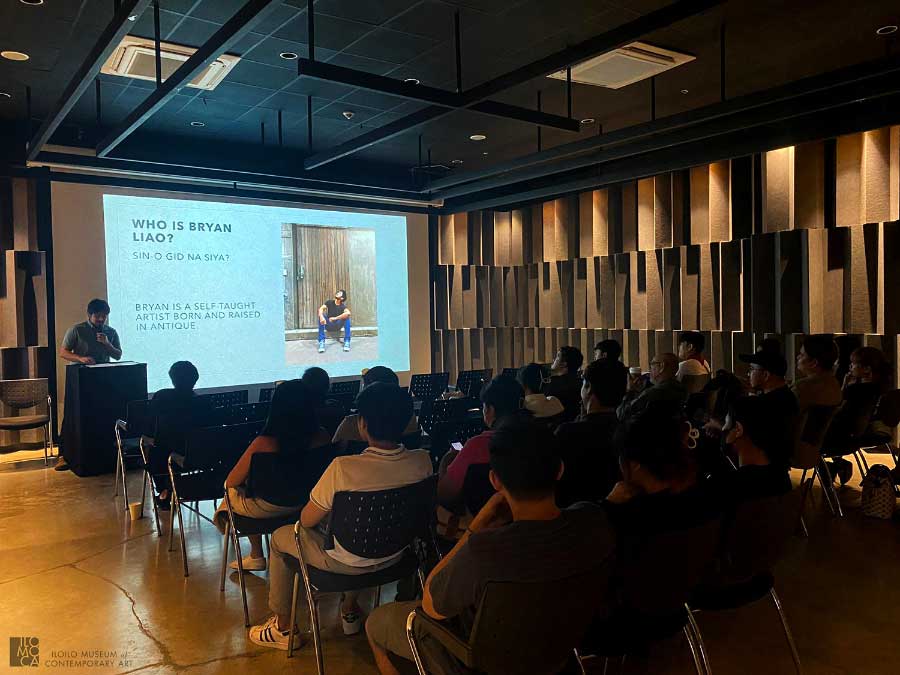By John Anthony S. Estolloso
Photos courtesy of ILOMOCA
NOTED American aesthete George Dickie proposes in his institutionalized definition of art that for artists to thrive and for artworks to be accepted, there should be an artworld comprised of afficionados, enthusiasts, and even critics ready to recognize these. More so would be the need for artworld systems – institutions that go beyond aesthetics – which augment the interrelationship between these roles, hence providing the groundwork that can either make or break the creation of art.
Easy to say this in a thriving artworld – but what does it bode for the artist in the absence of one?
Last July 8 opened to art enthusiasts of Panay a rare window into the fragile connections that hold art, artist, and audience together. Listening to Bryan Liao’s journey – and struggles – in establishing a viable artworld in his native Antique put the spotlight on the role of the artist in a community, if indeed there is a place for the creative impulse in circles that prefer the practical and the practicable over the purely aesthetic.
But what of Liao’s art? Harking back to his past exhibits, we find his usually trademark of iterations of wooden geometrical figures, curious tessellations that repeat themselves over and over again in assemblages: little blocks of wood measured and cut in the same dimensions put together to form figurative projections through heightened visual and tactile patterns. The finished artworks do not deviate much from this style yet each offers fresh perspectives by looking back to the basic mediums of installation art.
For the artist, it started with tinkering with these wooden figures. Eventually, these assemblages become expressions of a life run by routine. Educated in private schools where academic rigor is a badge of distinction and groomed to take on life as a careerman, Liao’s worldview surface in the simple yet rhythmic collection of bits and pieces that make up eye-catching – and sometimes illusory – panels and surfaces. Accented with paint and the occasional veneer that makes segments of his art ‘pop out’, the viewer senses a yearning for breaking out of the mold and finding the self in the corseted repetitions that surround it.
Taken altogether, Bryan Liao’s art is a personal existential commentary and reflection of his experience manifested through three-dimensional duplications, read as a whole.
Extending beyond the personal context of the artist would be the community that surrounds the making of the artwork. That there seems to be no ready audience to participate in the artistic experience further convolutes the circumstance: in this seemingly conflicted background of ideas comes the need for shared aesthetic understandings where struggling artist, experimental art, and hesitant audience can find common ground.
Liao’s narrative of sparking the fire of artistic appreciation made me look back into my classes in contemporary art. One point of contention that I love to reiterate time and again to my students is the willingness of people to accept and understand a work of art: ‘If a tree falls down in the middle of the forest and there is no one to hear it, was there sound produced?’ However, the question must not be taken out of context: plainly put, art essentially needs its appreciators and critics.
With this persistent query in mind, one has to the come to terms with the understanding that the readiness of a certain group of people to consider a particular product or performance as art rests primarily on the contexts that surround them: cultural consciousness, economic status, educational background, even political affiliations – all of which contribute to the community’s aesthetic tastes and preferences.
While Bryan Liao still has to beat a path through aesthetic ennui in his hometown, there is that sunny affirmation and reassurance that once seeds of appreciation have been planted, one can expect a flourishing and thriving to follow. Making headway through the thicket may seem a daunting task for the artist in search of his rightful place but if this is what it takes to jar people’s aesthetic sensibilities, then we heartily say, ‘Let him disturb the comfortable!’
So what’s next for Bryan Liao and the Antiqueño art scene? VIVA ExCon 2023 is waving and it subtly hints of a treasure trove of art and aesthetic experiences. Perhaps this might just be what Antique is waiting for.
[The writer is the Subject Area Coordinator for Social Studies in one of the private schools in the city. The photos are from ILOMOCA and are used with permission.]





















